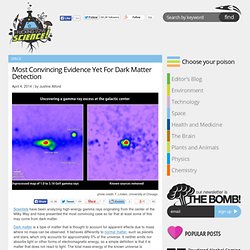

Most Convincing Evidence Yet For Dark Matter Detection. Scientists have been analyzing high-energy gamma rays originating from the center of the Milky Way and have presented the most convincing case so far that at least some of this may come from dark matter.

Dark matter is a type of matter that is thought to account for apparent effects due to mass where no mass can be observed. It behaves differently to normal matter, such as planets and stars, which only accounts for approximately 5% of the universe. It neither emits nor absorbs light or other forms of electromagnetic energy, so a simple definition is that it is matter that does not react to light. Rings Discovered Around an Asteroid for the First Time. Chariklo belongs to a class of asteroids called Centaur objects, which orbit primarily between Jupiter and Neptune (unlike the numerous main-belt asteroids between the orbits of Mars and Jupiter).

The Centaur object (10199) Chariklo orbits the sun between Saturn and Uranus and has a radius of about 124 kilometers. It’s the largest known Centaur object in the solar system, but still far, far smaller than Jupiter, Saturn, Uranus, and Neptune, which all have rings. Until now, rings in the Milky Way have been found exclusively around those four giant planets.
The two rings have been nicknamed Oiapoque and Chuí, after two rivers near the northern and southern extremes of Brazil. And they were revealed during observations of Chariklo passing in front of a distant star. A stellar occultation happens when a remote body (like an asteroid) eclipses a star, dimming the starlight briefly. Want more? According To A Nasa Funded Study, We're Pretty Much Screwed. Our industrial civilization faces the same threats of collapse that earlier versions such as the Mayans experienced, a study to be published in Ecological Economics has warned.

The idea is far from new, but the authors have put new rigor to the study of how so many previous societies collapsed, and why ours could follow. Lead author Mr Safa Motesharrei is no wild-eyed conspiracy theorist. Motesharrei is a graduate student in mathematics at the National Socio-Environmental Synthesis Center, a National Science Foundation-supported institution, and the research was done with funding from NASA's Goddard Space Flight Center. Water Vapor Detected in Exoplanet’s Atmosphere. Life as we know it requires liquid water, which is why those studying exoplanets search for traces of H2O in the atmospheres.

A team of astronomers, led by first author Alexandra Lockwood from Caltech, have detected water vapor on one of the alien planets nearest to Earth. The results were based on data obtained using the Near Infrared Echelle Spectograph (NIRSPEC) at the Keck Observatory in Hawaii and were published in The Astrophysical Journal Letters, with an open access version available on Arxiv. The planet, Tau Boötis b, is located about 51 light-years away and orbits the primary star of a binary system in the Boötes constellation. It is a hot Jupiter, which means that it is a gas giant, incredibly close to its parent star. Tau Boötis b is approximately 6-7 times more massive than Jupiter, but its distance from its star is only about one-seventh of the distance from Mercury to our Sun.
Tour Every Known Galaxy In The Universe. NASA Plans Mission To Europa. Much of the search for evidence for alien life has focused on looking for traces of ancient life on Mars, yet Europa is arguably a better candidate.

NASA’s 2015 budget request from the president includes money earmarked for the pre-formulation of a mission to send a probe to one of Jupiter’s moons. There have not yet been any official announcements from the Obama administration to specifically say that they want to make a mission to Europa a priority, but requesting funds for to investigate the possibility of going is being taken as a fairly good sign. Considering NASA has been trying to get this off the ground for the last 15 years, this is some long-awaited good news. The Milky Way Project. Has The First Dark Matter Particle Been Found? The existence of dark matter has been known for decades, but working out what it is actually made from has been a frustrating quest.

Now, however, Professor David Cline has told a UCLA symposium of the finding of what could be the first cold dark matter particle, an object weighing 30 billion electron volts. The first evidence for dark matter emerged in 1932 when Jan Oort noted that objects are circling the galactic plane as if our galaxy has substantially more mass than we can see. Further study on other galaxies found the same pattern. Two main theories emerged: Weakly Interacting Massive Particles (WIMPS) or Massive Compact Halo Objects (MACHOs). Rule Breaking Black Hole Discovered. M83 is a galaxy which is a popular target for astronomers and is currently being mapped in detail by the Hubble Space Telescope, Magellan Telescope, Chandra X-Ray Observatory, Australia Telescope Compact array, and the Very Large Array.

Simulations back up theory that Universe is a hologram. Artist's impression by Markus Gann/Shutterstock At a black hole, Albert Einstein's theory of gravity apparently clashes with quantum physics, but that conflict could be solved if the Universe were a holographic projection.

A team of physicists has provided some of the clearest evidence yet that our Universe could be just one big projection. In 1997, theoretical physicist Juan Maldacena proposed1 that an audacious model of the Universe in which gravity arises from infinitesimally thin, vibrating strings could be reinterpreted in terms of well-established physics.